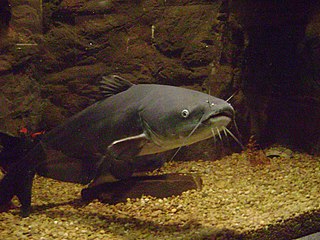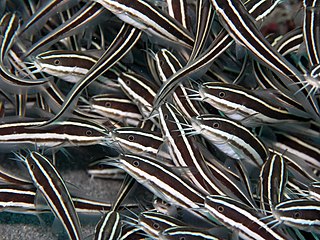
Catfish are a diverse group of ray-finned fish. Named for their prominent barbels, which resemble a cat's whiskers, catfish range in size and behavior from the three largest species alive, the Mekong giant catfish from Southeast Asia, the wels catfish of Eurasia and the piraíba of South America, to detritivores, and even to a tiny parasitic species commonly called the candiru, Vandellia cirrhosa. There are armour-plated types and there are also naked types, neither having scales. Despite their name, not all catfish have prominent barbels. Members of the Siluriformes order are defined by features of the skull and swimbladder. Catfish are of considerable commercial importance; many of the larger species are farmed or fished for food. Many of the smaller species, particularly the genus Corydoras, are important in the aquarium hobby. Many catfish are nocturnal, but others are crepuscular or diurnal.

The flathead catfish, also called by several names including mudcat or shovelhead cat, is a large species of North American freshwater catfish. It is the only species of the genus Pylodictis. Ranging from the lower Great Lakes region to northern Mexico, they have been widely introduced and are an invasive species in some areas. The closest living relative of the flathead is the widemouth blindcat, Satan eurystomus.

Mouthbrooding, also known as oral incubation and buccal incubation, is the care given by some groups of animals to their offspring by holding them in the mouth of the parent for extended periods of time. Although mouthbrooding is performed by a variety of different animals, such as the Darwin's frog, fishes are by far the most diverse mouthbrooders. Mouthbrooding has evolved independently in several different families of fish.

Hypostomus plecostomus, the suckermouth catfish or common pleco, is a tropical fish belonging to the armored catfish family (Loricariidae), named for the armor-like longitudinal rows of scutes that cover the upper parts of the head and body. Although the name Hypostomus plecostomus is often used to refer to common plecostomus sold in aquarium shops, most are actually members of other genera.
The suckermouthed catfish is a tropical fish belonging to the armored suckermouth catfish family (Loricariidae). Hypostomus punctatus is a freshwater fish native to South America, in the coastal drainages of southeastern Brazil and Uruguay. It is one of a number of species commonly referred to as 'plecostomus' or 'common pleco' by aquarists.

The walking catfish is a species of freshwater airbreathing catfish native to Southeast Asia. It is named for its ability to "walk" and wiggle across dry land, to find food or suitable environments. While it does not truly walk as most bipeds or quadrupeds do, it has the ability to use its pectoral fins to keep it upright as it makes a wiggling motion with snakelike movements. This fish normally lives in slow-moving and often stagnant waters in ponds, swamps, streams and rivers, flooded rice paddies or temporary pools which may dry up. When this happens, its "walking" skill allows the fish to move to other sources of water. Considerable taxonomic confusion surrounds this species and it has frequently been confused with other close relatives.

The blue catfish is the largest species of North American catfish, reaching a length of 165 cm (65 in) and a weight of 68 kg (150 lb). The typical length is about 25–46 in (64–117 cm). The fish can live to 20 years. The native distribution of blue catfish is primarily in the Mississippi River drainage, including the Missouri, Ohio, Tennessee, and Arkansas Rivers, and the Rio Grande, and south along the Gulf Coast to Belize and Guatemala. These large catfish have also been introduced in a number of reservoirs and rivers, notably the Santee Cooper lakes of Lake Marion and Lake Moultrie in South Carolina, the James River in Virginia, Powerton Lake in Pekin, Illinois, and Springfield Lake in Springfield, Illinois. This fish is also found in some lakes in Florida. The fish is considered an invasive pest in some areas, particularly the Chesapeake Bay. Blue catfish can tolerate brackish water, thus can colonize along inland waterways of coastal regions.

Basa is a species of catfish in the family Pangasiidae. Basa are native to the Mekong and Chao Phraya basins in Indochina. These fish are important food fish with an international market. They are often labelled in North America and Australia as "basa fish", "swai", or "bocourti". In the UK all species of Pangasius may legally be described as "river cobbler", "cobbler", "basa", "pangasius", "panga", or any of these with the addition of "catfish". In the rest of Europe, these fish are commonly marketed as "pangasius" or "panga". Other related shark catfish may occasionally be incorrectly labeled as basa fish, including P. hypophthalmus and P. pangasius.

The black bullhead or black bullhead catfish is a species of bullhead catfish. Like other bullhead catfish, it has the ability to thrive in waters that are low in oxygen, brackish, turbid and/or very warm. It also has barbels located near its mouth, a broad head, spiny fins and no scales. It can be identified from other bullheads as the barbels are black, and it has a tan crescent around the tail. Its caudal fin is truncated. Like virtually all catfish, it is nocturnal, preferring to feed at night, although young feed during the day. It generally does not get as large as the channel or blue catfish, with average adult weights are in the 1- to 2-lb range, and almost never as large as 4 lb. It has a typical length of 8-14 in, with the largest specimen being 24 in, making it the largest of the bullheads. It is typically black or dark brown on the dorsal side of its body and yellow or white on the ventral side.

Chaca is the only genus in the catfish family Chacidae. These fish are commonly known as squarehead catfishes, frogmouth catfishes, or angler catfishes. These unusual fish have a sedentary lifestyle and spend much of their time motionless.

Horabagrus brachysoma or the sun catfish is a species of catfish endemic to rivers in the Western Ghats of India. It is known as Günther's catfish or yellow catfish. It is also known as Manjakoori in its native range. It is also known by a host of other names, such as bullseye catfish, golden red tail catfish, solar catfish, and sun catfish.

Farlowella acus is the type species of a genus of armored catfish commonly known as the twig catfish or whiptail catfish. The species name means “pointed” or a “needle” or “spine”.

The giant talking catfish or giant raphael catfish is a species of thorny catfish that is native to the Amazon Basin in Bolivia, Brazil, Colombia, Ecuador and Peru. This species grows to a length of 60 centimetres (24 in) SL and a maximum weight of 4.6 kilograms (10 lb). These fish are a component of local commercial fisheries.

The ripsaw catfish or cuiu cuiu is a species of thorny catfish native to the Amazon, Essequibo and São Francisco basins in Bolivia, Brazil, Colombia, Ecuador, Guyana, Peru and Venezuela. This species grows to a length of 100 centimetres (39 in) SL and weights up to 13 kilograms (29 lb). This species is a minor component of local commercial fisheries. Has lateral thorns that can damage a potential predator or handler. It feeds by shifting through sand and detecting eatable parts with the taste receptors in the roof and floor of its mouth.

Plotosus is a genus of eeltail catfishes native to the Indian Ocean, the western Pacific Ocean and New Guinea.

Cavefish or cave fish is a generic term for fresh and brackish water fish adapted to life in caves and other underground habitats. Related terms are subterranean fish, troglomorphic fish, troglobitic fish, stygobitic fish, phreatic fish and hypogean fish.

Batrachocephalus mino, the beardless sea catfish, is the only species of catfish in the genus Batrachocephalus of the family Ariidae. This species occurs in marine and brackish waters of Bay of Bengal, and parts of the western central Pacific, in coastal waters, estuaries, and lower reaches of rivers. It is distributed from Pakistan, India, Sri Lanka, Bangladesh, Myanmar, Malaysia, Thailand, to Indonesia.

Galeichthys feliceps, the white barbel, sea barbel, white baggar or white sea catfish, is a species of sea catfish found in coastal waters and estuaries over muddy bottoms at depths of from 1 – 120 metres where they gather in large shoals. They occur from Namibia to South Africa with questionable records of sightings from Madagascar and Mozambique in Africa and the United States of America and Mexico in North America. It is coloured brown, grey or greenish-brown on the upperparts and is paler below. While most grow to a length of 35 cm, some individuals attain a length of 55 cm with a record of a fish from South Africa weighing 3.8 kg.
The Guinean sea catfish, also known as the Marine catfish, is a species of sea catfish in the family Ariidae. It was described by Albert Günther in 1864, originally under the genus Arius. It is a tropical fish which is found in Mauritania, Angola, Morocco and the Spanish Sahara. It inhabits coastal marine waters at a depth range of 50 to 80 m, also frequently entering estuaries and freshwater rivers. It reaches a maximum total length of 70 cm (28 in), more commonly reaching a TL of 40 cm (16 in).
The Madamango sea catfish, also known as the Raspfin sea catfish or the Spring cuirass, is a species of catfish in the family Ariidae. It was described by Louis Agassiz in 1829. It is a tropical, marine and brackish water-dwelling catfish which occurs between Colombia and Brazil. It inhabits a depth range between 1 to 50 m. It reaches a maximum total length of 30 cm (12 in), more commonly reaching a TL of 20 cm (7.9 in).





















